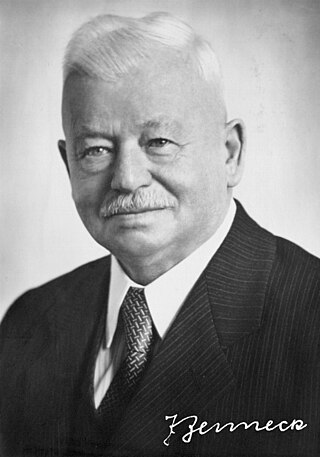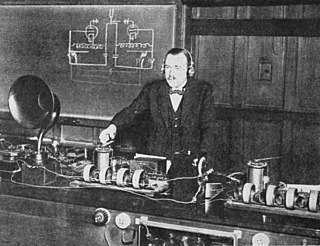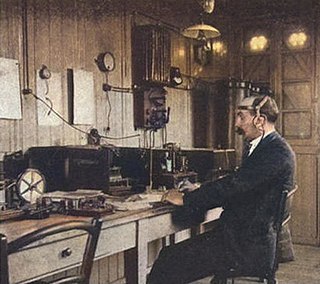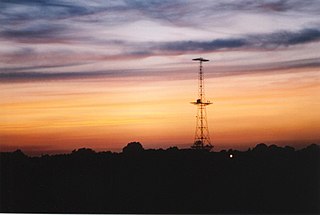
Guglielmo Giovanni Maria Marconi, 1st Marquis of Marconi was an Italian inventor and electrical engineer, known for his creation of a practical radio wave-based wireless telegraph system. This led to Marconi being credited as the inventor of radio, and he shared the 1909 Nobel Prize in Physics with Karl Ferdinand Braun "in recognition of their contributions to the development of wireless telegraphy".

Sir John Ambrose Fleming FRS was an English electrical engineer and physicist who invented the first thermionic valve or vacuum tube, designed the radio transmitter with which the first transatlantic radio transmission was made, and also established the right-hand rule used in physics.

Karl Ferdinand Braun was a German electrical engineer, inventor, physicist and Nobel laureate in physics. Braun contributed significantly to the development of radio and television technology: he shared the 1909 Nobel Prize in Physics with Guglielmo Marconi "for their contributions to the development of wireless telegraphy", was a founder of Telefunken, one of the pioneering communications and television companies, and has been both called the "father of television" and the co-father of the radio telegraphy, together with Marconi.
The Royal Radar Establishment was a research centre in Malvern, Worcestershire in the United Kingdom. It was formed in 1953 as the Radar Research Establishment by the merger of the Air Ministry's Telecommunications Research Establishment (TRE) and the British Army's Radar Research and Development Establishment (RRDE). It was given its new name after a visit by Queen Elizabeth II in 1957. Both names were abbreviated to RRE. In 1976 the Signals Research and Development Establishment (SRDE), involved in communications research, joined the RRE to form the Royal Signals and Radar Establishment (RSRE).

Jonathan Adolf Wilhelm Zenneck was a German physicist and electrical engineer who contributed to researches in radio circuit performance and to the scientific and educational contributions to the literature of the pioneer radio art. Zenneck improved the Braun cathode ray tube by adding a second deflection structure at right angles to the first, which allowed two-dimensional viewing of a waveform. This two-dimensional display is fundamental to the oscilloscope.

Sir Edward Victor Appleton was an English physicist, Nobel Prize winner (1947) and pioneer in radiophysics. He studied, and was also employed as a lab technician, at Bradford College from 1909 to 1911.

Alexander Stepanovich Popov was a Russian physicist, who was one of the first persons to invent a radio receiving device.

William Henry Eccles FRS was a British physicist and a pioneer in the development of radio communication.
Sir Richard Tetley Glazebrook was an English physicist.

The invention of radio communication was preceded by many decades of establishing theoretical underpinnings, discovery and experimental investigation of radio waves, and engineering and technical developments related to their transmission and detection. These developments allowed Guglielmo Marconi to turn radio waves into a wireless communication system.

Sir John Sealy Edward Townsend, FRS was an Irish-British mathematical physicist who conducted various studies concerning the electrical conduction of gases and directly measured the electrical charge. He was a Wykeham Professor of physics at Oxford University.

Marconi Research Centre is the former name of the current BAE Systems Applied Intelligence Laboratories facility at Great Baddow in Essex, United Kingdom. Under its earlier name, research at this site spanned military and civilian technology covering the full range of products offered by GEC-Marconi, including radio, radar, telecommunications, mechatronics and microelectronics.
The timeline of radio lists within the history of radio, the technology and events that produced instruments that use radio waves and activities that people undertook. Later, the history is dominated by programming and contents, which is closer to general history.

Balthasar van der Pol was a Dutch physicist.
Frank Farmer OBE was an English physicist, and a pioneer in the application of physics to medicine, particularly in relation to the practical aspects of cancer treatment by radiation.
David Hardy Whiffen FRS was an English physicist and pioneer of infrared and Electron Spin Resonance known for the "Whiffen Effect".

John Ashworth Ratcliffe CB CBE FRS was an influential British radio physicist.
Sir George Gray Macfarlane was a British engineer, scientific administrator and public servant.
Sir Eric Eastwood CBE FRS, was a British scientist and engineer who helped develop radar technology during World War II.
Charles Herach Papas was an American applied physicist and electrical engineer, known for his contributions to electromagnetic theory, microwaves, radiophysics, gravitational electromagnetics, astrophysics, guided waves, and remote sensing.












